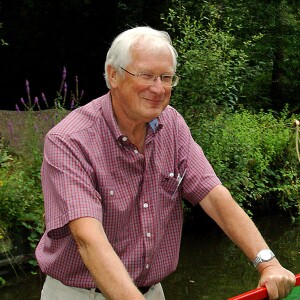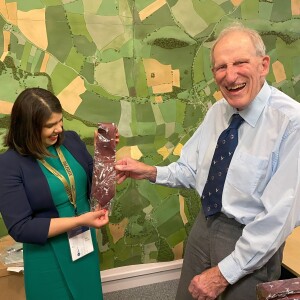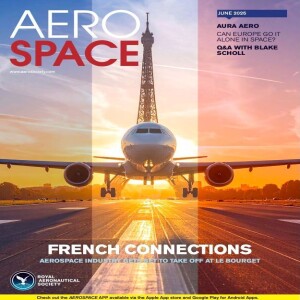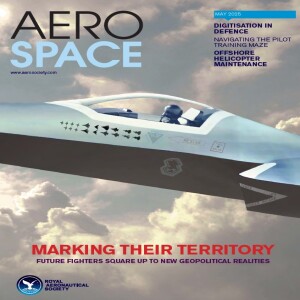Royal Aeronautical Society Podcast
The Royal Aeronautical Society is the world’s only professional body dedicated to the entire aerospace community. Established in 1866 to further the art, science and engineering of aeronautics, the Society has been at the forefront of developments in aerospace ever since.
Episodes

4 days ago
4 days ago
From British Aircraft Corporation (BAC) and into BAE Systems (BAe), as one of BAe’s senior lawyers, Philip Riley FRAeS was well positioned to witness the people, the projects and the issues that shaped the British aircraft ndustry from the mid-1960s to the early years of the present century, living and breathing the roller coaster of amalgamations, nationalisations, mergers and privatisations that characterised the industry during those years.
Philip relished the opportunity to travel the world negotiating contracts and financial packages supporting the sale of aircraft such as the BAC One Eleven whilst working with some of the big names in aviation. During his early years at BAC, he decided to pursue a legal qualification - an ambitious move that ultimately led him to become a member of the company’s Legal Department as an in-house Solicitor. In that role he was involved in major contract negotiations, acquisitions and mergers including the privatisation of BAe, collaboration with Airbus partners and the amalgamation with GEC Marconi in 2000. In this conversation, Philip shares stories about the people he worked with and the challenges that the company faced.
After retiring from BAE Systems, Philip remained passionate about aviation. He became the secretary of the Farnborough Aerodrome Consultative Committee (formed by TAG, the operator of the airport) and subsequently became Chairman of that Committee.
His enthusiasm for aviation heritage led him to play a role in safeguarding heritage within BAe and ensuring that BAe’s rich heritage was preserved and protected for future generations.
As a founding member and the first Chairman of the Royal Aeronautical Society’s Farnborough Branch, Philip has made lasting contributions to the Society. He has also served as Treasurer and a member of the Society’s Council, and was involved in the re-location of the Society’s library to Farnborough (from its London HQ) and in the establishment of the National Aerospace Library at Farnborough. Philip reflects on the town’s rich contribution to the UK’s aviation heritage and its continued importance in the field.
Philip continues to be to be active in the community, currently supporting RAF Odiham in commemorating its centenary and participating in the aviation section of his local U3A branch.
Philip Riley FRAeS talked with Julian Temple, Heritage Archivist for BAE Systems Heritage, on 30 September 2024. The podcast was edited by Eur Ing Mike Stanberry FRAeS and is published by kind permission of BAE Systems for the Royal Aeronautical Society/National Aerospace Library’s oral history project ‘If I only didn’t do it that way…….” Capturing history from the horse’s mouth to inspire today’s aeronautical professionals.
A transcript of the interview recording is available on the National Library's Catalogue: https://raes.soutron.net/Portal/Default/en-GB/RecordView/Index/4182317

Tuesday Jun 24, 2025
Tuesday Jun 24, 2025
After leaving Ferrari, Arthur struck-out on his own as an engineering consultant, with projects ranging from trolley buses in post-Cold War Hungary to designing MRI scanner beds and defence work. One of clients, St Bernard’s Composites, liked working with him so much that they offered him the role of Technical Director with a seat on the board. Arthur recalls some of the interesting projects St. Bernard’s did with the likes of Rolls-Royce, Airbus, Martin-Baker and Imperial College.
Eur Ing Arthur Webb FRAeS was interviewed by Tony Pilmer FRAeS in 2024 and 2025 as part of the Royal Aeronautical Society/National Aerospace Library’s oral history project ‘If I only didn’t do it that way…….” Capturing history from the horse’s mouth' to inspire today’s aeronautical professionals'. The recording was edited by Eur Ing Mike Stanberry FRAeS.

Tuesday Jun 24, 2025
Tuesday Jun 24, 2025
When John Barnard was tempted to join Ferrari there was only one man that he wanted to cook-up his carbon fibres and do the stressing – Arthur Webb. They had a year to create the Guildford Technical Office (GTO) before the car needed to reach the grid. Of course, Arthur also had to go to Maranello and get the thumbs up from the great man, Enzo Ferrari.
Eur Ing Arthur Webb FRAeS was interviewed by Tony Pilmer FRAeS in 2025 as part of the Royal Aeronautical Society/National Aerospace Library’s oral history project ‘If I only didn’t do it that way…….” Capturing history from the horse’s mouth' to inspire today’s aeronautical professionals'. The recording was edited by Eur Ing Mike Stanberry FRAeS.

Tuesday Jun 24, 2025
Tuesday Jun 24, 2025
After not liking the way the nationalised BAC was going, Arthur Webb left Weybridge and headed to the small, secret and innovative special projects office of ML Aviation then onto Marconi Space. Here he tells us a little about working on drones, the JP233 anti-runway bomb for the Tornado, Skynet 4 and ESA’s Eureka project.
Eur Ing Arthur Webb FRAeS was interviewed by Tony Pilmer FRAeS in 2024 as part of the Royal Aeronautical Society/National Aerospace Library’s oral history project ‘If I only didn’t do it that way…….” Capturing history from the horse’s mouth' to inspire today’s aeronautical professionals'. The recording was edited by Eur Ing Mike Stanberry FRAeS.

Tuesday Jun 10, 2025
Tuesday Jun 10, 2025
In the latest podcast in series from the Royal Aeronautical Society's monthly AEROSPACE magazine, Editor in Chief Tim Robinson and Deputy Editor Stephen Bridgewater are joined by freelance author Charlotte Bailey to analyse recent aviation, aerospace and space news - and preview the latest (June 2025) edition of the magazine. In this episode, we also interview incoming RAeS President Alasdair Wood FRAeS. Find out more at www.aerosociety.com

Wednesday May 28, 2025
Wednesday May 28, 2025
When a young John Barnard was appointed as McLaren’s designer, he decided that carbon fibre was the future of Formula 1, but who should he ask to help him with his design? The answer was Arthur Webb of BAC. For a bit of fun in his own time, Arthur became McLaren’s unofficial carbon fibre consultant. Over the next few years, John and Arthur designed, tested and constructed the first carbon fibre shell of a Formula 1 car – a feet which not only made the car go faster, but saved drivers’ lives.
Arthur also describes other carbon fibre projects, such as how they worked to bring carbon fibre into rowing. We also explore his last years at BAC, including his work on Concorde before describing the depressing time that led up to the nationalisation of Britain’s aircraft industry.
Eur Ing Arthur Webb FRAeS was interviewed by Tony Pilmer FRAeS in 2024 as part of the Royal Aeronautical Society/National Aerospace Library’s oral history project ‘If I only didn’t do it that way…….” Capturing history from the horse’s mouth' to inspire today’s aeronautical professionals'. The recording was edited by Eur Ing Mike Stanberry FRAeS.

Wednesday May 28, 2025
Wednesday May 28, 2025
After marching up to the front gate of the BAC Weybridge factory and demanding to see the Chief Stressman, Arthur Webb was given the job of finding something useful to do with the new magic composite material discovered at the Royal Aircraft Establishment – carbon fibre.
In this part of his oral history interview, Arthur explores how he led a team to design the first certified civil aircraft component for an aeroplane, a pair of load carrying rudder panels on a VC10, with no data, no experience and no background. Arthur also retells the amazing story of he, thanks to good contacts and a lot of guile, persuaded Rolls-Royce that they too should use carbon fibre for structural applications.
Eur Ing Arthur Webb FRAeS was interviewed by Tony Pilmer FRAeS in 2024 as part of the Royal Aeronautical Society/National Aerospace Library’s oral history project ‘If I only didn’t do it that way…….” Capturing history from the horse’s mouth' to inspire today’s aeronautical professionals'. The recording was edited by Eur Ing Mike Stanberry FRAeS.

Wednesday May 28, 2025
Wednesday May 28, 2025
Stressing the 3-spar wing Armstrong-Whitworth Series 220 Argosy and the massive Lockheed C5 Galaxy wings was a fascinating way for an aero engineer in his twenties and early thirties to begin his career. As well as describing the design challenges, including the Argosy’s early use of bonded composites, Arthur shares what it was like during the brain drain: firstly working on the Galaxy for a UK contractor, before then moving to the USA with his young family and experiencing the racial tensions of 1960s Georgia.
Between working on the two freighters, he was selected as one of the few that moved from Coventry to Kingston, and tells us about his work keeping Second World War legacy aircraft in the air and his brush with one of the most dominant figures of twentieth century military aviation, Sir Sydney Camm HonFRAeS.
Arthur starts his oral history interview with telling us about watching British aircraft overhead from German occupied Jersey and how, after an encounter with Prof AD Young FRAeS, scraped through Queen Mary’s Aeronautical Engineering degree by the skin of his teeth.
Eur Ing Arthur Webb FRAeS was interviewed by Tony Pilmer FRAeS in 2024 as part of the Royal Aeronautical Society/National Aerospace Library’s oral history project ‘If I only didn’t do it that way…….” Capturing history from the horse’s mouth' to inspire today’s aeronautical professionals'. The recording was edited by Eur Ing Mike Stanberry FRAeS.

Wednesday May 07, 2025
Wednesday May 07, 2025
In this podcast series from the Royal Aeronautical Society's monthly AEROSPACE magazine, Editor in Chief Tim Robinson, Deputy Editor Stephen Bridgewater and Features Editor, Jack Richardson analyse recent aviation, aerospace and space news - and preview the latest (May 2025) edition of the magazine. In this episode, we also interview outgoing RAeS President David Chinn FRAeS. Find out more at www.aerosociety.com

Wednesday Apr 16, 2025
Wednesday Apr 16, 2025
From the sonic booms of Concorde to the cockpits of fighter aircraft, noise has always been a problem for aviators. Dr Graham Rood spent a fascinating career reducing the negative effects of sound, including groundbreaking research into helmet-based noise cancelling systems, and, in retirement, has joined colleagues at the Farnborough Air Sciences Trust (FAST) to safeguard the legacy generations of aeronautical researchers who worked in the birthplace of British aviation.
After receiving excellent all-round training as a Royal Aircraft Establishment (RAE) apprentice, Graham joined the Ministry of Defence’s Inspection Directorate, where he worked closely with aero engine companies. The role was both interesting and deeply satisfying, but his thirst for hands-on engineering led him to Christchurch, where he took on the role of Eng3 at the Royal Signals and Radar Establishment (SRDE), initially focusing on mobile power systems for the army.
His career progressed with a move to Boscombe Down where he worked at the Aeroplane and Armaments Experimental Establishment (A&AEE). During this period, Graham embarked on a part-time MSc at Southampton University’s Institute of Sound and Vibration. This research involved investigating the sonic booms of Concorde—a fascinating challenge that ultimately led him to pursue a PhD.
In 1974, he returned to Farnborough, where he became immersed in tackling cockpit noise, a problem that threatened to make communication impossible in low-flying jets. Determined to find solutions, Graham worked on developing advanced helmets and noise-cancellation systems. His role as a Flight Observer in fast jets allowed him to test and refine these innovations firsthand. His expertise and dedication saw him rise to become Head of the Acoustics and Vibration Section within the Man-Machine Integration Department.
Even after formally retiring, Graham’s passion for aviation and engineering remained undiminished. As one of QinetiQ’s Trusted Experts, he continued to lend his knowledge to the field. But it was his involvement with FAST that marked the beginning of a second career. Initially focused on preserving historic buildings, he soon took on the monumental task of saving vast archives of photographs, reports, and records that were at risk of being lost and forgotten. Thanks to Graham and his colleagues, future generations will be able to access and learn from the 100 years of pioneering technical and scientific work of the RAE.
Dr Graham Rood FRAeS talked with Roger Cansdale FRAeS on 28 January 2025 for the Royal Aeronautical Society/National Aerospace Library’s oral history project ‘If I only didn’t do it that way…….” Capturing history from the horse’s mouth to inspire today’s aeronautical professionals. … . The podcast was edited by Eur Ing Mike Stanberry FRAeS.
The transcript of the recording can be accessed on the National Aerospace Library's catalogue.





